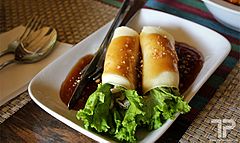Lumpiang ubod facts for kids
 |
|
| Alternative names | heart of palm spring rolls, coconut pith spring roll, palm spring rolls |
|---|---|
| Course | Appetizer |
| Place of origin | Philippines |
| Region or state | Silay, Negros Occidental |
| Serving temperature | hot, warm |
| Main ingredients | heart of palm, lumpia wrapper |
| Variations | lumpiang Silay |
Lumpiang ubod, also known as heart of palm spring rolls, is a yummy Filipino snack or appetizer. It's like a spring roll filled with thin strips of ubod (which is the soft, inner part of a heart of palm plant). It also has different meats and vegetables, all wrapped in a thin, pancake-like wrapper made from egg.
You can usually eat lumpiang ubod fresh, and it's called lumpiang sariwa (fresh lumpia). But sometimes, people also deep-fry it until it's crispy. This dish first came from the city of Silay in Negros Occidental, where a special kind called lumpiang Silay is still very popular today.
Contents
What is Lumpiang Ubod?
Lumpiang ubod gets its name from ubod, which means "heart of palm". This is the soft, edible inside part of a coconut tree trunk. It's a bit like the core of a cabbage, but from a palm tree!
Where Did It Come From?
This tasty dish started in the city of Silay, which is in the province of Negros Occidental on Negros Island in the Visayas region of the Philippines. Long ago, people say it was a popular snack served at gatherings where wealthy people played games like mahjong. Servers would carry these spring rolls on woven trays called bilao.
The ubod used in the spring rolls came from fresh coconut trees. These trees are very common in Ilonggo cuisine (the food from that area). Lumpiang ubod became so popular that it spread to other parts of the Philippines. Over time, it started to look and taste more like the common fresh spring rolls, lumpiang sariwa.
How Lumpiang Ubod is Made

Most of the time, lumpiang ubod is served as lumpiang sariwa (fresh lumpia). To make it, the heart of palm and carrots are cut into very thin strips. These strips are then mixed with chopped garlic, onion, and other vegetables. Sometimes, people add cabbage, green beans, singkamas (jicama), or potatoes.
You can also add meat like pork, beef, or chicken, or even shrimp or tofu. All these ingredients are cooked together quickly in a pan with spices and patis (fish sauce). They are cooked until the ubod is soft and any meat is fully done.
The Wrapper and Serving
The wrapper for lumpiang ubod is thicker than the ones used for fried spring rolls. It can be made at home or bought from a store. It's made by mixing egg, flour, and water to create a thin batter. This batter is then poured onto a hot pan to make a thin, pancake-like wrapper.
Once the wrapper is ready, a small amount of the cooked filling is placed on a lettuce leaf. Then, it's carefully wrapped up. Fresh lumpiang ubod is usually served with a drizzle of peanut sauce. It's often topped with green onions, crushed unsalted peanuts, toasted garlic, or crushed chicharon (crispy pork rinds).
Fried Lumpiang Ubod
Sometimes, lumpiang ubod is deep-fried. When it's fried, it's called lumpiang prito. The way you prepare the filling is pretty much the same. The type of wrapper used is not as important for fried versions. After it's deep-fried until golden and crispy, it's served with your favorite dipping sauce, just like other fried spring rolls.
Lumpiang Silay: The Original Version
The original lumpiang ubod from Silay is sometimes called lumpiang Silay, lumpiang Ilonggo, lumpiang ubod de Silay, or lumpiang Bacolod. Unlike other versions, this one is always served fresh.
It's usually smaller and thinner, about the size of a finger. Traditionally, it includes ubod, cooked meat (ground or in strips), shrimp, a whole sprig of green onion, and crushed chicharon on a bed of lettuce. The wrapper for lumpiang Silay is often made with rice flour.
What's special about lumpiang Silay is how it's served. It doesn't come with a dipping sauce on the side. Instead, the sauce is spread inside the wrapper before it's rolled. This sauce is usually made from cornstarch, salt, sugar, soy sauce, and finely crushed toasted garlic. Because it was originally a finger food, it's often served wrapped in wax paper.

